Is green mold good or bad? I've asked that question myself dozens of times over the past decade or so that I've been curing meats and sausages. Up until recently, I would reject any mold other than white, green included. It was fear that guided me. My fear was the result of a lack of knowledge. But now, I've changed my mind. My new batch has green mold on it, and I am just fine with it. I actually dig the look.
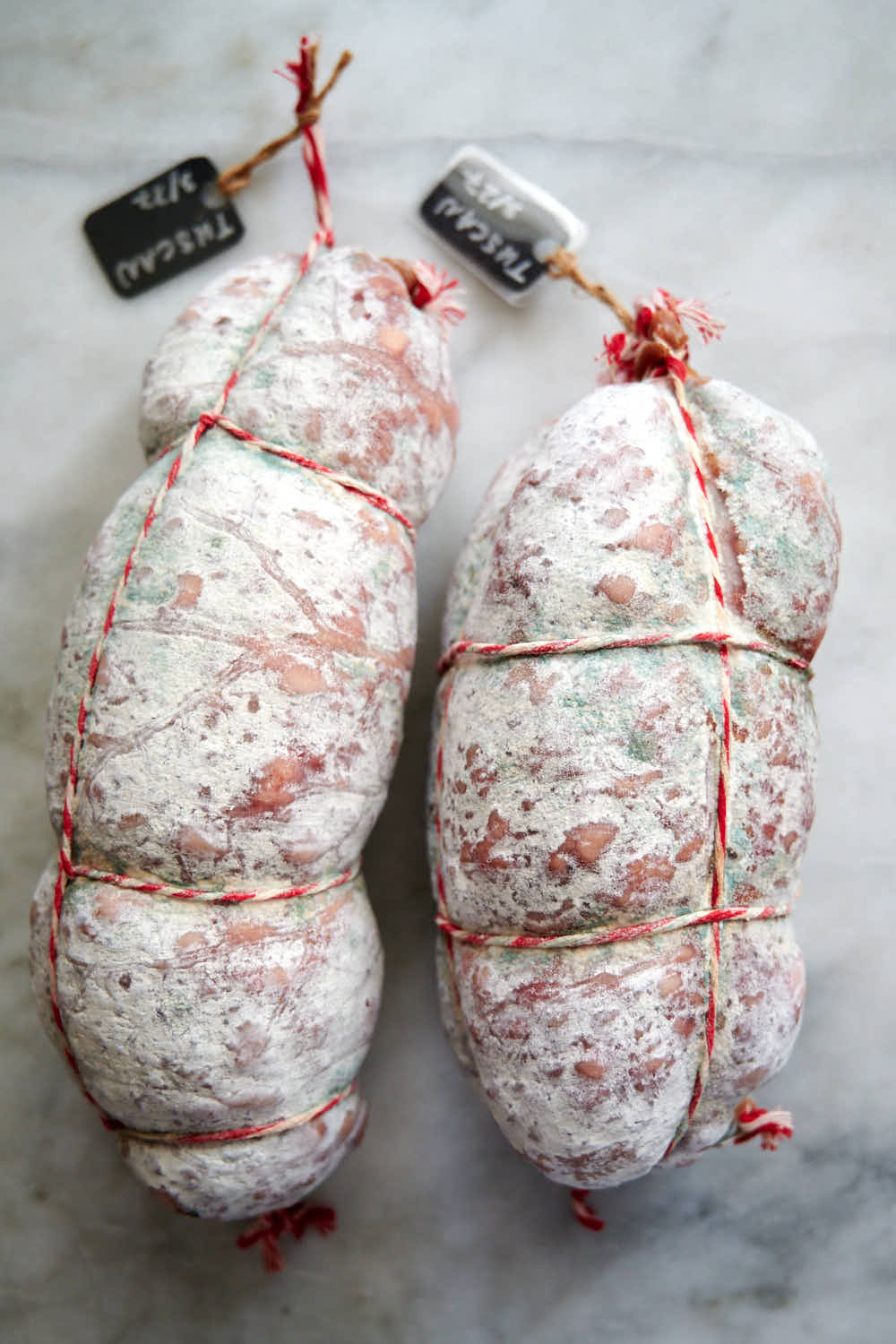
But what do we know about green mold? Is all green mold good or bad? Or some green molds are good, and some are bad? Is green mold avoidable? I now seem to have a clear answer to those questions.
Why and when green mold appears?
Up until recently, I dry cured my salami at the standard 55F / 75% RH. Green mold rarely appeared on my sausages, which were inoculated with white mold. I use naturally occurring white mold collected from previous batches. When inoculated with a more active Mold-600, chances of green mold appearing are practically zero. Here is a picture of Fuet that I finished just recently. It was cured at 76%-78% RH and, as you can see, there is not a hint of green mold on it.
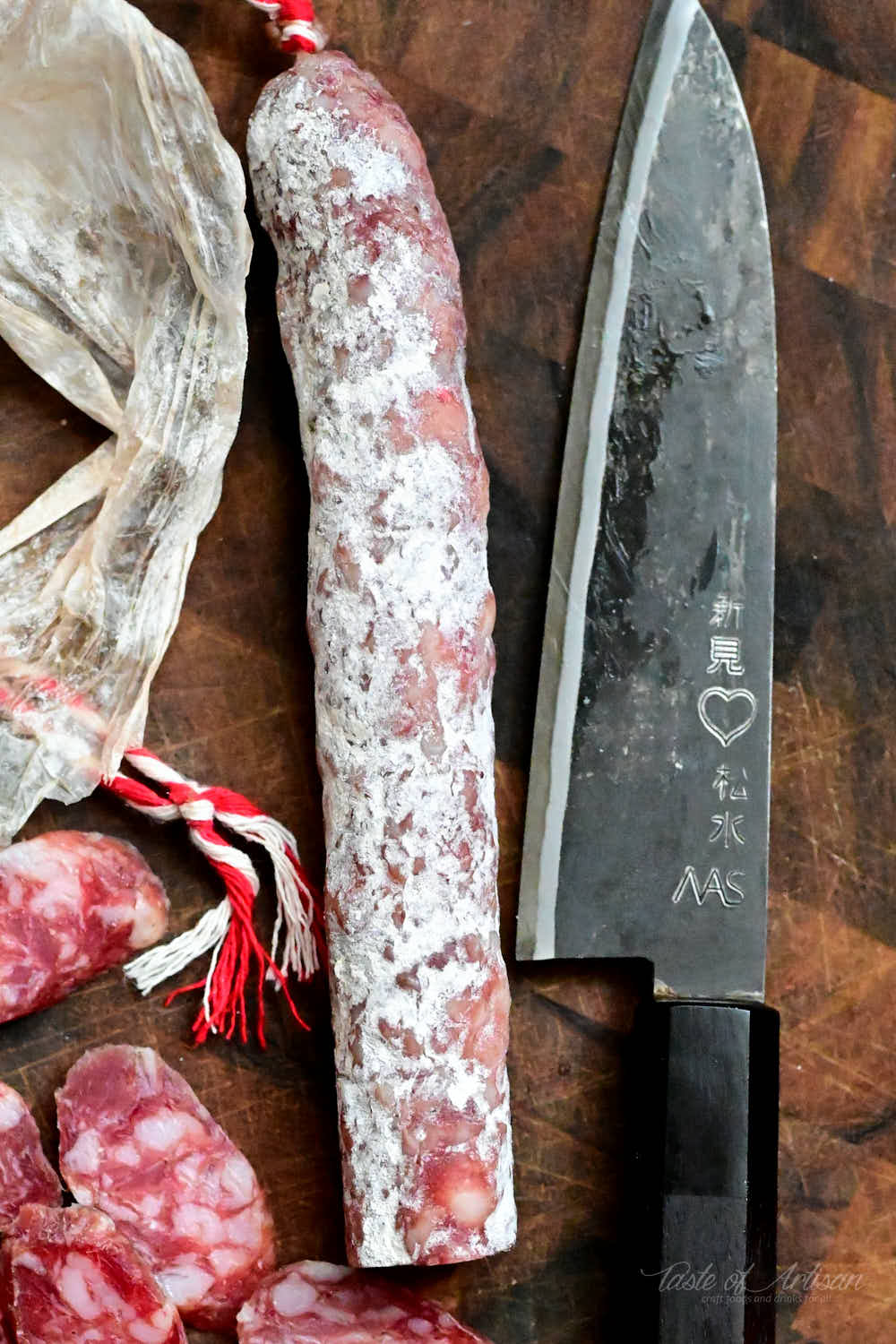
My current batch is maturing at 55F - 57F and 80% - 86%RH. Despite inoculating with white mold which appeared pretty quickly, if a little patchy, I began to see areas of green mold soon after. The green mold initially appeared around the damper areas, like the creases caused by the twine. I wiped it with a 50/50 mix of white vinegar and distilled water. A week later, the green mold appeared in many other areas. There was a lot of it too. Is it a disaster, or is it a normal part of curing salami at a higher humidity?
Now, green mold can also happen if the environment or the casings are contaminated with the green mold spores. I am going to rule out this possibility simply because I sterilize my curing chamber with bleach before every new batch, and I am very particular about cleanliness when working with meat. Every tool I use to process meat gets treated with a solution of bleach, gloves, etc.
Is green mold avoidable?
I would say yes. In general, the higher the humidity, the more molds, including green, will appear. Most, if not all, of my batches, dry-cured at 75%-78% RH did not develop green mold. As such, I can confidently say that high humidity is the cause. By lowering the humidity, you can almost certainly avoid green mold. This is assuming that the environment is not contaminated with green mold spores.
Is green mold good or bad though?
Now, this is a million-dollar question. I am trying a new approach where my salami are matured at higher humidity. This is new to me but is commonly done in Italy and many other places I presume. I have the green mold on my sausages. What do I do? The answer is: IT DEPENDS.
Patchy, bright green, hairy, nasty looking, bad smelling mold is bad. Here is an example of bad green mold.
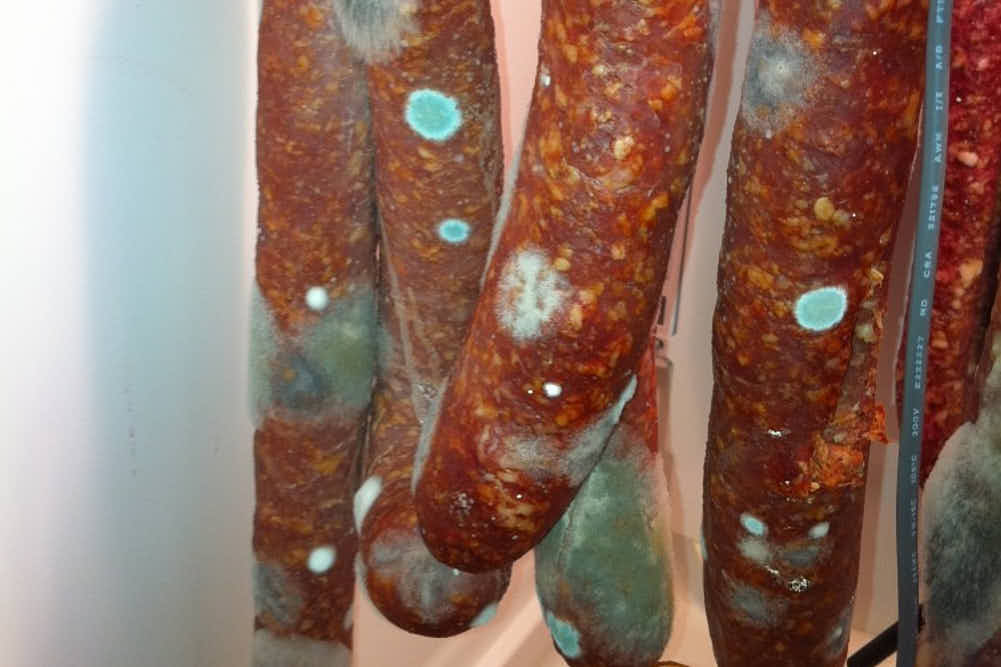
Is there a good green mold? Certainly. The typical white mold that we see on salami is Penicillium nalgiovense. However, in recent years, scientists found a different strain of mold from the Penicillium family, Penicillium salamii. Like the common white mold, this particular mold has a green color and does not produce mycotoxins, toxic substances that can have harmful effects on human health. In fact, this green mold is found on salami all over the world.
On the other hand, when the commonly found white mold - Penicillium nalgiovense - blooms, or grows aggressively, it acquires green color. That's why we see pictures of salumerias showcasing cured meats and sausages covered in green mold. Photo's below are courtesy of eGallet forums. They have an interesting discussion on green salami mold there.
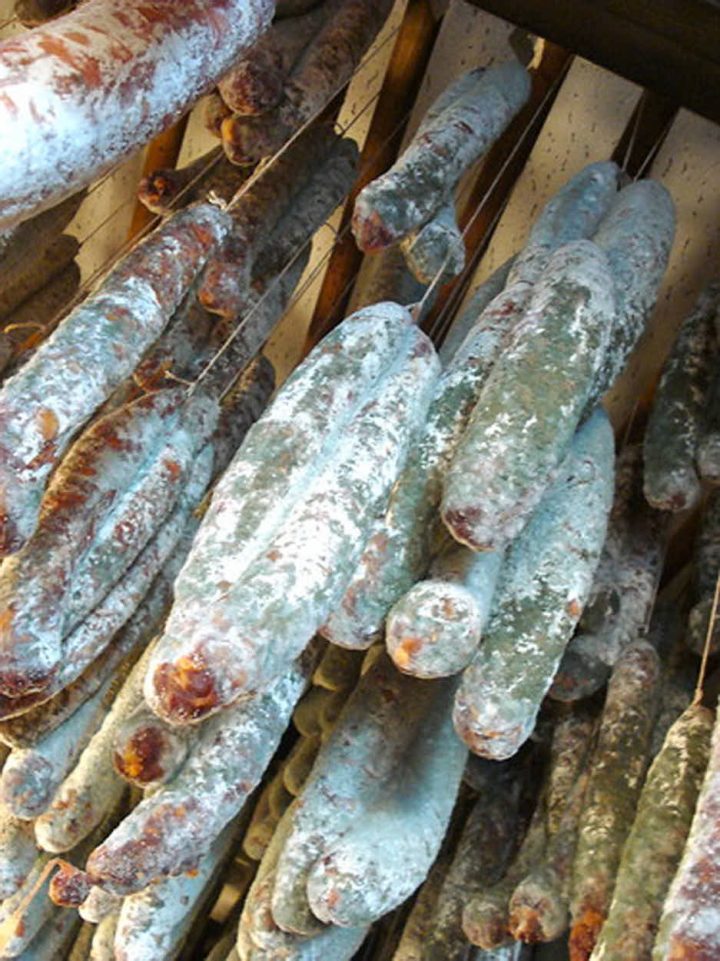
Here is another interesting image of salumi covered in green mold, typical of cellar-matured meats at about 80-85% Rh:
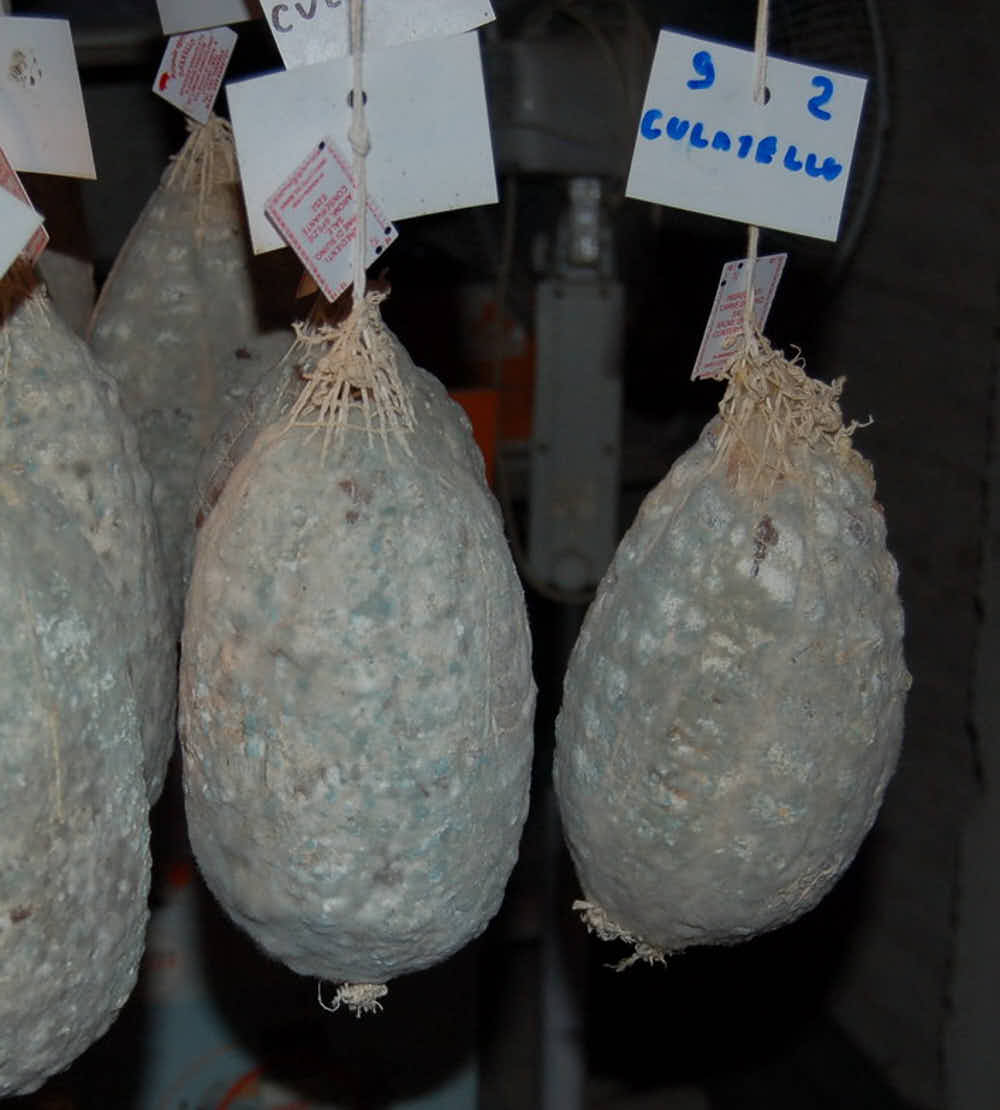
How to tell good green mold from bad?
That's another million dollar question. Searching the internet for the images of Penicillium salamii produced basically nothing. The only reputable source I was able to find was the Federation of European Microbiological Societies that had an article on Penicillium salamii strain ITEM 15302. Luckily, it had a fantastic illustration of Penicillium nalgiovense and Penicillium salamii after 7 and 13 days of seasoning (maturing).
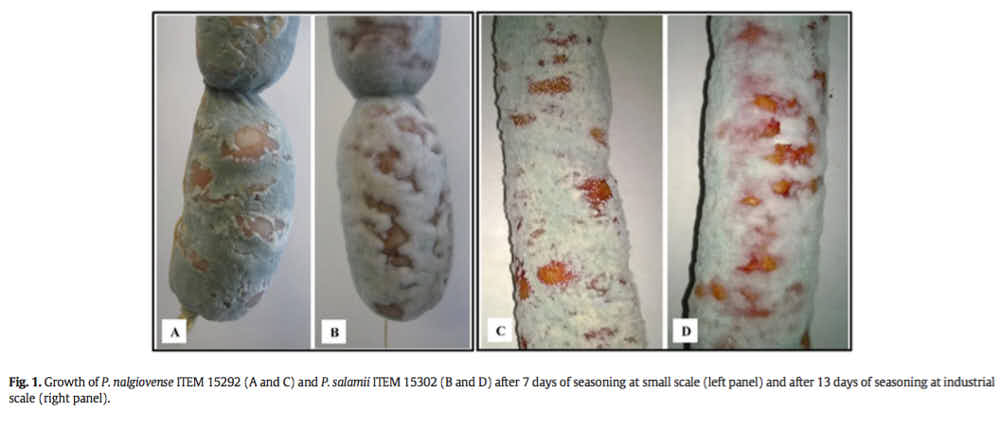
As you can see, both strains exhibit green color, though Penicillium salamii is more of creamy, light green. I am surprised about the green color of Penicillium nalgiovense though. But it looks like the color changes over time. Perhaps humidity affects that as well.
A butcher-friend from Italy, when asked about what he thought about green mold, said this: white mold, the favorite for cured meats, is the first to appear on salami, but is very weak and during the long maturation phase tends to disappear to give way to more aggressive, gray and green molds. But those molds do not create problems; you only need to worry if yellow or black ones appear. However, the molds must be smelled to understand if they have unpleasant smells that we would then find in the product. Smells of pepper, earth, peas, potatoes, mushrooms, camphor, peppers, moldy cellar are good. Naturally, molds that give off unpleasant smells must be removed by brushing them off.
Green mold on my salami
After fermentation and drying at low humidity for 7 days, my salami entered maturation stage. As I mentioned above, I will be maturing them at 55F - 57F and 80% - 86%RH. I noticed green mold on the second day in a few spots. I wiped it off with a vinegar solution. A week later, I see green mold everywhere.
It's different though. It has the same texture/feel as white mold. It's chalky, powdery.
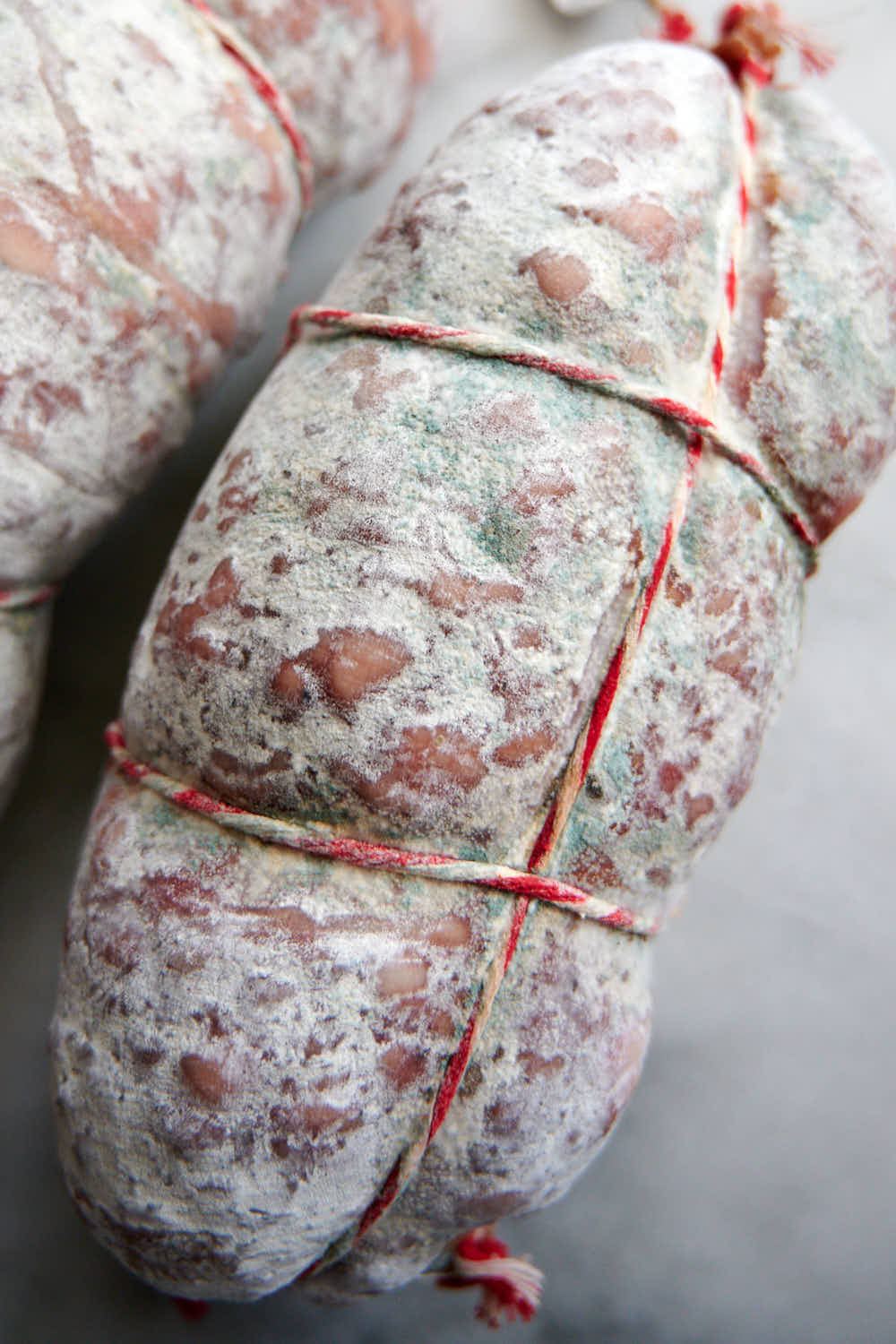
Comparing to the pictures of the Penicillium nalgiovense and Penicillium salamii above, it looks very similar to Penicillium nalgiovense. I compared the smell of the green mold and the white one, and they both seem to smell the same. I could not tell any difference. Needles to say, I am quite comfortable with leaving this green mold as is and I can't wait to see how my salami look and taste after they fully mature.
Update on green mold two weeks later (April 18, 2020)
Two weeks later my green mold is practically gone. I can now confidently conclude that it was, in fact, Penicillium nalgiovense. The green coloration was caused by blooming that occurred during the initial stages of mold growth.
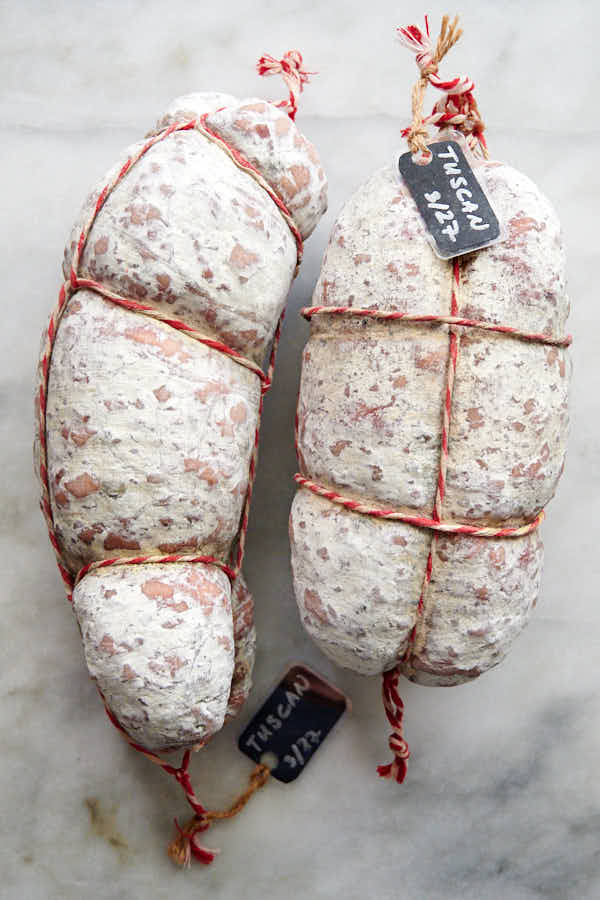
More examples of good green mold
I did some digging around and was able to find more examples of good green mold that looks similar to mine. These don't seem very widespread, I am curious to know why.
From Biocoop Cestas
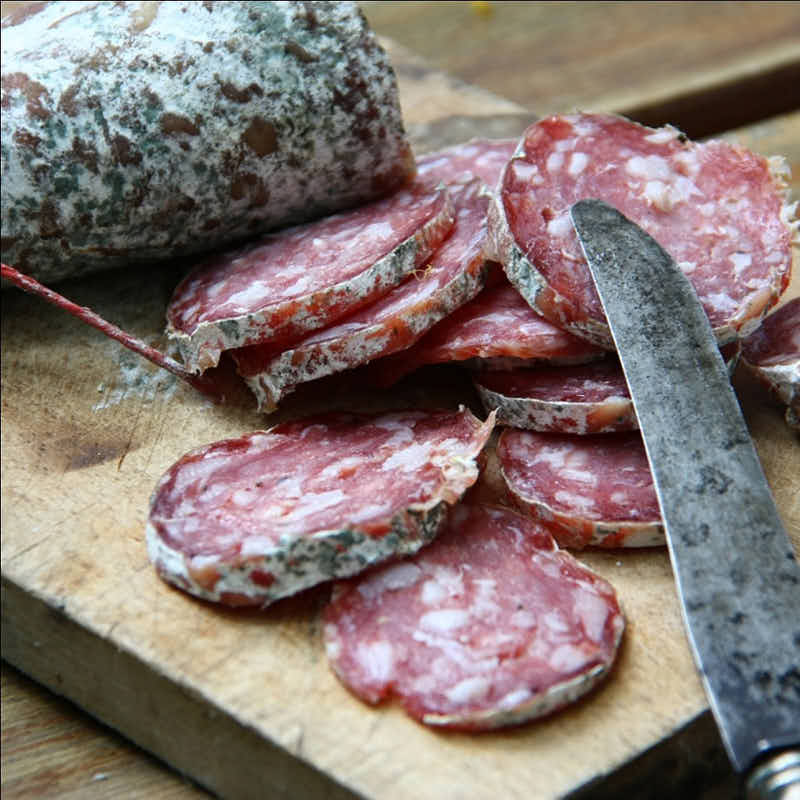
From Le blog Saucisson
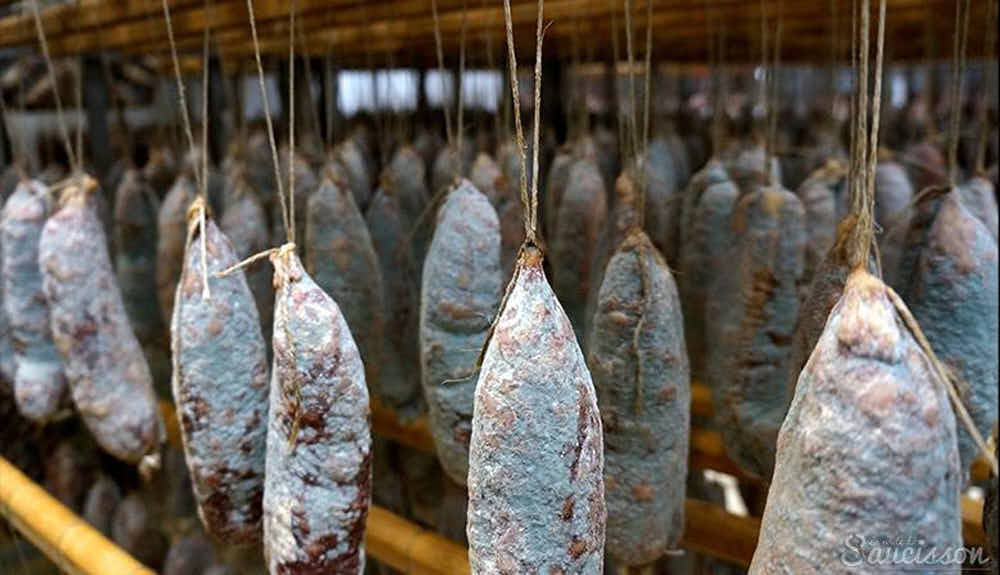
From Ferme Chazal
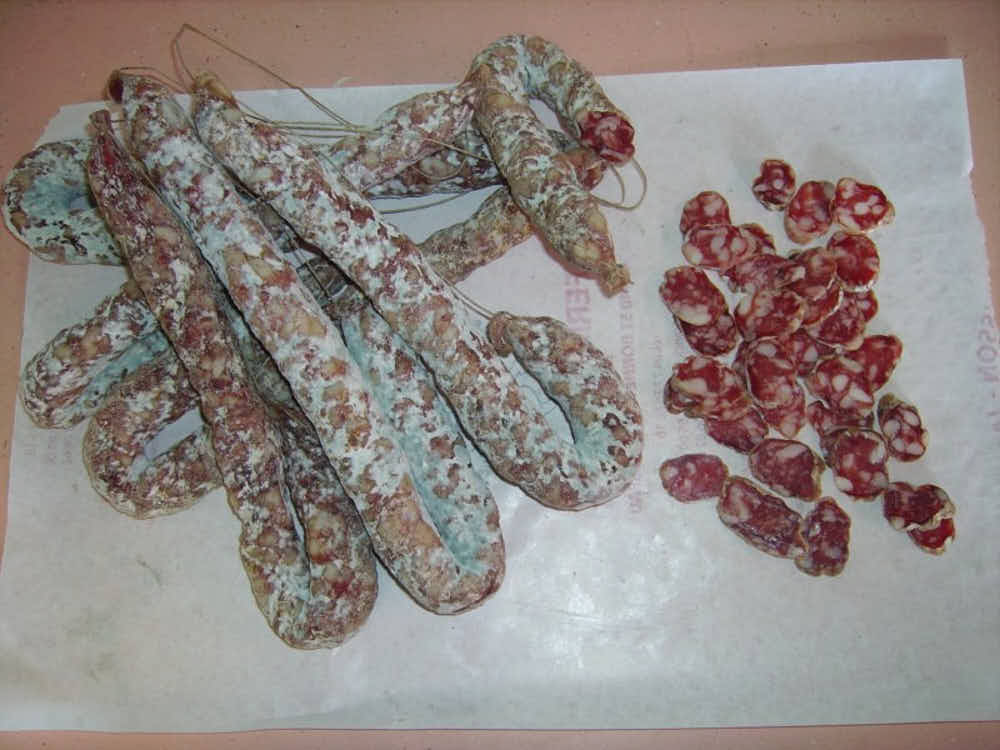
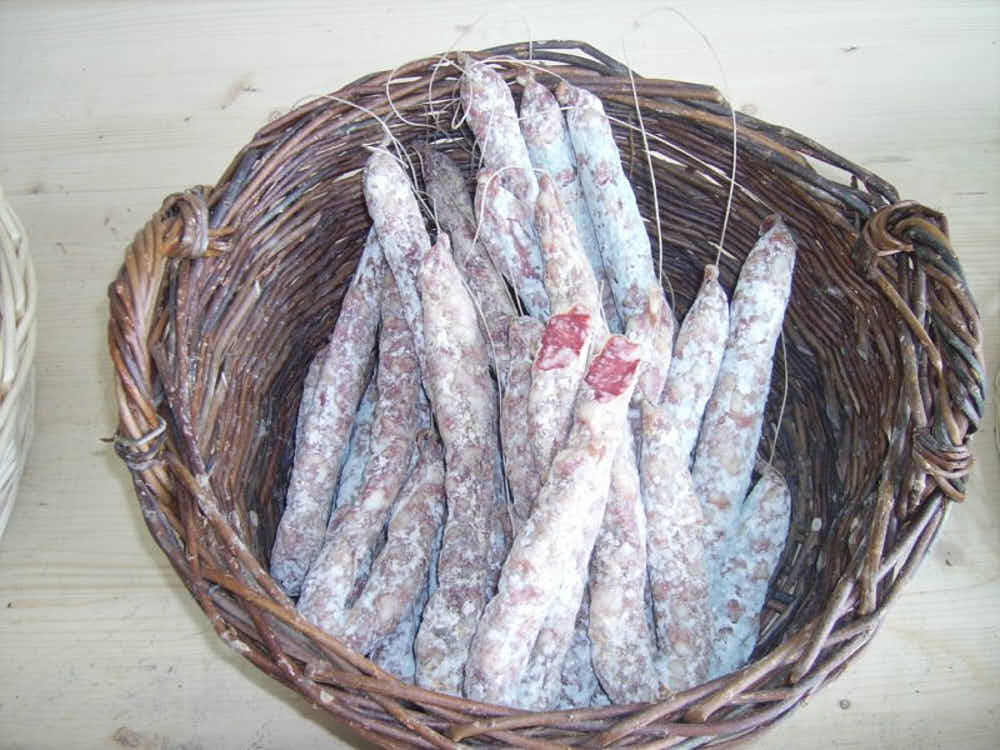
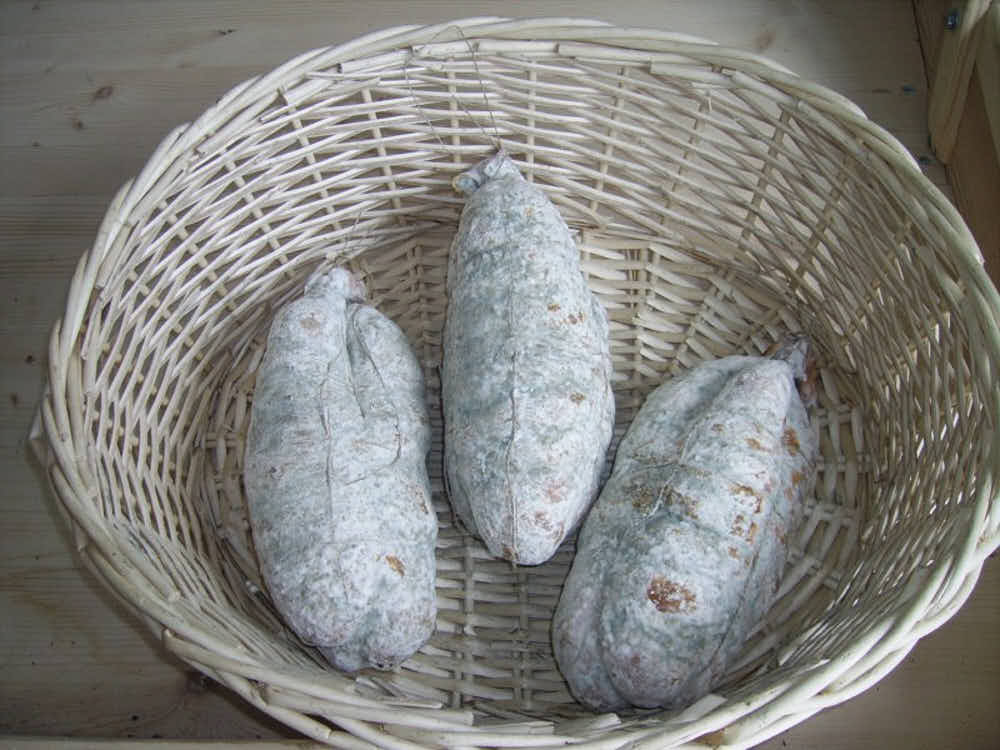
From Boucherie Senegas
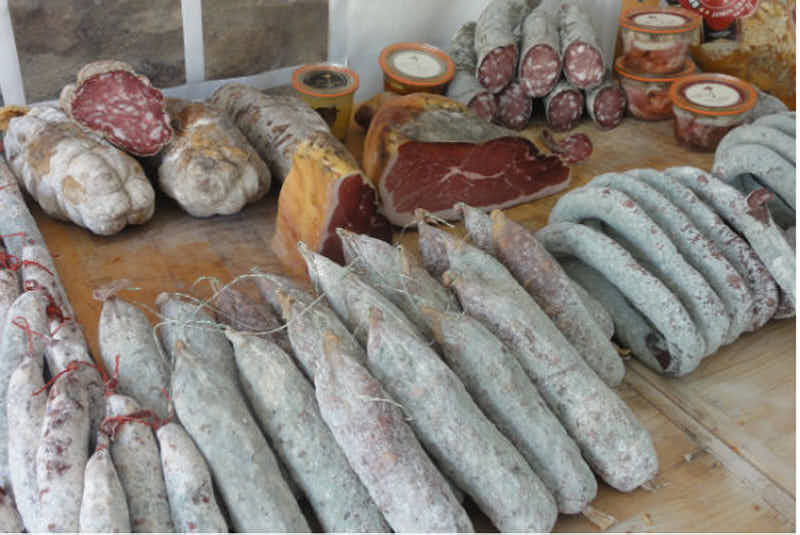


Jake says
I'm drying some Capicolo and Guanchiale right now and I'm getting some green mold on it. I really can't figure out if it's good or bad, if I should wipe it down or not.
Victor @ Taste of Artisan says
Send me some pics, I can take a look. I will email you.
Elizabeth says
Hello! I am learning and curing chorizo for the first time. Using the small fridge and I only can maintain it at 48 degrees F and 66% RH. Would a few degrees lower affect the curing process? Also, I have a question about white molds. Should I wipe them down? I read that the molds are 'beneficial'.
Thank you,
Liz
Victor @ Taste of Artisan says
Hello, Elizabeth! 48F is less than optimal (53-57F) but should work and you can get a decent flavor development. I mean, Umai folks put meat in the fridge (36-38F) for a few weeks and seem to be happy with the results. 66% RH is low and may cause case hardening though and result in an uneven drying. I've noticed that if let the sausage fully dry, as in make hard salami, lower humidity is fine, as eventually the uneven drying between the sides and the center will even out.
White mold is fine. In fact, you want it for a more even drying and it helps reduce acidity of the meat, resulting in a milder tang. Good luck!
Anthony Kimber says
Terrific , well written read. I am dealing into curing/aging , and found this very reassuring! Cheers
Victor @ Taste of Artisan says
Glad you found it helpful, Anthony. I struggled with this issue initially and had a lot of doubts along the way with each batch. Thought I'd make a quick write up on this to help other who are new to this hobby. Good luck!
John Renner says
Butcher and Packer sells Mold 600. They are in Michigan. Amazon also. Package says it is PENICILLIAN NAIGIOVENSE
JoeA says
I'm still trying to get my hands on some P. Salamii. The green colour is something I'm very familiar with in Calabria, and it produces a distinctly different (and personally preferable) aroma than that of P. Nalgiovense. I've read quite a number of articles about it however, no indication of how one can find a genuine sample. If anyone has access, I would be willing to pay for a viable sample
Victor @ Taste of Artisan says
The study that I read a while ago - https://www.sciencedirect.com/science/article/abs/pii/S0168160514005273 - indicated that P. salamii is present on cured products worldwide and co-exists with P. nalgiovense, where one or the other will dominate.
Can it be isolated and cultivated in isolation? Maybe... maybe not. Regardless, very soon indigenous strains will come in and begin to colonize the surface... unless you introduce an overwhelming count of yeast that will overwhelm any other strain. I think, depending on conditions, one or the other will dominate in the long run. They may actually exist in a symbiotic relationship and you may actually want to have them both, plus any other strains floating around your cellar. Isolated commercial bread yeast strain will never compete with multiple wild yeast strains found in sourdough when it comes to flavor. I think it may be true here as well. I don't know, I stopped using Bactoferm Mold-600 a long time ago as I disliked the overly strong smell it was producing and the aggressive growth that always seemed to interfere with proper drying/maturing.
I don't know if you can buy isolated P. salamii anywhere, I've never seen it sold, but the mold that I have on my cured products is quite good. I collected samples from a number of artisanal sausages made in Italy and France and introduced them to my environment. I would collect the best samples after maturing is done and save them (vac sealed and frozen) for use on new batches. It's an ongoing process and so far the mold that I get on my salami has a very nice aroma (to me anyway) and a nice color. Perhaps this is the route you can explore. Good luck!
Smokin' Yuma says
Great article, thank you! I have cured and am now drying my first pork neck, covered with penicillium nalgiovense. After a week of drying the meat is fully covered in a thick white layer. But I do expect it to turn greenish at some point. Your article helped me getting a better feel for what might be coming. Best regards from The Netherlands.
Victor @ Taste of Artisan says
Glad to hear that my article helped, Smokin' Yuma. Good luck with you first pork neck. Hope it turns out fabulous.
Ken T says
Good Afternoon, I am trying to cure prosciutto and have done some other curing of salami and Elk eye of round with good success. I have built my curing cabinet off of all of your build that you have posted. I have had my leg of pork in the cabinet now since December 6th, so 13 weeks now at 53 degrees and RH at 75 to 78%. The leg is covered in green mold, does not have a bad smell, but has only lost 1.75 lbs, started at 20.05 lbs and as of last night is down to 18.26? Any suggestions would be greatly appreciated. Should I lower the humidity? Thank you in advance
Victor @ Taste of Artisan says
Hello Ken, which process are following? As in, are you trying to replicate Parma, San Daniele, Toscano, etc.? They have slightly varying processes. Or are you just winging it? Prosciutto typically follows a double salting process with rests in between, drying, then curing. The humidity will depend on the stage and can vary from 50-90%. Often the ranges for different styles are quite large. IN the end, you are looking at 30-35% weight loss.
In general, yes, you will need to lower humidity to lose weight. But there are many nuances to that.
The green mold is fine if it's simple Penicillium nalgiovense that bloomed and turned dark greenish/greyish color over time. That's totally normal and is expected for proper curing.
JoeA says
Is anyone aware of availability of Penicillium salamii for purchase? There's been much discussion of it for years now. I can't find any salumi maker who can confirm they've worked with it, or even a meat product having been made using it.
Victor @ Taste of Artisan says
Never came across it myself, and I am also interested.
JOHN R RENNER says
Penicillium nalgiovense... I believe that is the name for Bactoferm Mold 600 that you apply to the outside of the meat after fermentation.
Penicillium nalgiovense is an anamorph species of the genus Penicillium with lipolytic and proteolytic activity, which was first isolated from ellischau cheese. This species produces dichlorodiaportin, diaportinol, and diaportinic acid Penicillium nalgiovense is used for the maturation of certain fermented salami varieties and ham. In this process it protects the meat from colonization by other molds and bacteria
Victor @ Taste of Artisan says
Joe was asking about the Penicillium salamii strain; it's different from Penicillium nalgiovense. Mold-600 is a single isolated Penicillium nalgiovense strain. Speaking of which, IMHO it's too aggressive and has an unpleasant smell that inevitably propagates to the meat. I stopped using it many years ago. I selectively collected naturally occurring local Penicillium nalgiovense strains and that's what I've been using ever since. Those have a nice smell, not aggressive, and bloom to a nice light green color, which changes to dark green color over time at higher humidity. I would recommend using naturally occurring local strains over Mold-600. This is from my recent batch.
Victor @ Taste of Artisan says
Joe, on the other hand, as this article reiterates, P. salamii naturally occurs worldwide alongside P. nalgiovense. Here is what they say: "In our study, P. salamii predominated the salami and capocollo surface in levels similar to the commonly known starter culture P. nalgiovense, irrespective of the room or age of seasoning. Preliminary inoculation trials with P. salamii showed that it was able to colonize salami during seasoning, indicating that this species could be used as a fungal starter for dry-cured meat." Source: https://www.sciencedirect.com/science/article/abs/pii/S0168160514005273.
I think there is a good chance that I and others who harvest local strains may already be using P. salamii in the mix. I have to caution that when you harvest locally occurring P. strains it's important to recognise that their composition will vary from batch to batch. I've had some batches where mold strains that dominated had less than pleasant smell and bloomed to a dark grey, unappealing color. It's important to experiment and harvest only the best examples, hopefully the ones where P. sallamii dominates or at least has a large proportion. I know, it would be easier to use an isolated P. salamii strain but this seems like a viable option.
Now, if you use an isolated P. salamii, would it give you the most optimal results? How will it coexist with the local P. strains? Will it dominate or succumb to them? I don't know. I tend to think that collecting the best examples of local P. strain mixes, healthy, with good aroma and color, is the best way to go.
Joe says
Hello, im not a sausage/salami maker but rather a buyer
Theres two types of salami i can find here, a bulkier, more filled one and another greasier, thinner and smoked one
The greasy one while able to host white mold more often than not ends up green and/or hairy after a short while yet the former holds well for a few weeks even out of the fridge, all white (until they die off that is)
Both get stored at the same place, during the same period and i buy them both without any (visible) mold to begin with so its not like either has a kickstart in good/bad mold
They do have different casings and meat/fat composition from one another; could this change the mold preference/fixation on it?
Victor @ Taste of Artisan says
Joe, I think it's entirely possible. I've seen variations in mold behavior depending on the type of casing I was using, thickness, and water activity/dryness of the sausage. Smoked sausages typically should be less prone to mold development as smoke acts as a preservative having antimicrobial properties. Mind you though, just because you buy a sausage without mold, it doesn't mean it wasn't there. Often sausages are rinsed/wiped before selling to make them look presentable. Lots of spores will be left behind and will begin to grow as soon as you put the sausage into favorable conditions.
Bosco says
Smelling molds should be done with caution.....or not at all.
Mold spore can be inhaled and cause serious health issues.
It can cause aspergilloma.
Pulmonary aspergilloma is a mass caused by a fungal infection. It usually grows in lung cavities. The infection can also appear in the brain, kidney, or other organs. Aspergillosis is an acute pulmonary infection caused by the aspergillus fungus.
I spent years working in a gourmet deli and every day I saw customers grabbing bunches of mushrooms from the produce department and smelling them, deeply inhaling, trying to determine if they were fresh or not. Bad idea.
Victor @ Taste of Artisan says
Thanks for the warning, Bosco. I don't recommend inhaling the spores of nasty-looking mold either but my experience is that once they develop and I open my curing chamber I can immediately smell a foul odor. No need to get up close and personal with it. But I haven't had those in a long time.
George says
Hello, I currently have fuet hanging in my fridge at around 65(f) and 80%-82%(rh). I noticed within 24 hours after hanging for 10 days that spots of blue and even black appeared on the casings. After sacrificing on, cutting it open and seeing that the mold had not penetrated the sausage, I felt wiping the mold off with white vinegar to be sufficient. My curing set up is an older refrigerator with a small humidifier hooked up to and ink bird temp/humidity control and a constantly running small desk fan. As you, I noticed there was more mold growing in the folds and crevasses so I am thinking the humidity may be to high and not circulating enough. I have since drilled a 2' hole into the side of the fridge to act as a vent but I am seriously considering buying a dehumidifier as well. Any input or advice would be greatly appreciated. I really enjoyed your article and found it very informative. Thanks
Victor @ Taste of Artisan says
Hi George, 65F at a 10 day mark is too high. It's fine for fermentation / drying which for fuet will take a few days, but rest should be 55F - 57F. This explains why you'd be getting unwanted molds growing on the surface. That high temp coupled with high humidity that is. 80-82% Rh is also on the higher end... you can try 76-78% to prevent excessive mold growth, it should work fine for a thinner sausage like fuet.
Holes and fans in the curing chamber never really worked for me, they actually had a negative effect most of the time. A peltier dehumidifier is what saved the day for me.
Shawn says
if you see green mold why don't you just wipe it off?
Victor @ Taste of Artisan says
If it's Penicillium nalgiovense and Penicillium salamii mold - the good green mold - you don't need to wipe it off, it's beneficial.This is essentially white mold that turns green when it's blooming at very high humidity.
Talor Migliaccio says
I too have encountered green mold on my products. In particular, when I raised my humidity to high 80's low 90's for cheese maturation in the same space. I went off smells (hadn't seen your excellent article) contacted a few freinds, and just went with it. All is well! They go through almost exactly the timeline you describe, 7 days white, by two weeks fully green, and then they switch/change to more grey's. I even get some b.linen growth! I'd love to show you pictures. Email me and I'll send you my set up and progress shots of my mold growth.
Victor @ Taste of Artisan says
Hey, Talor... thanks for your contribution. Email sent.
John Renner says
when serving/eating- is the green wiped off?
Victor @ Taste of Artisan says
Well, I typically remove the casing before slicing and serving so you don't see any mold, white or green. If you want to slice with the casing on, yes, I would wipe it with a damp cloth/paper towel. You can even rinse with water and wipe thoroughly, then slice. By the way, as I mentioned in the post, green color shows up during the blooming stage of the mold development, it turns white/greyish later... If you keep the humidity high, it may persist though.
Pepo says
We see this good green mold frecuently in the salami made in Colonia Caroya, where the green ones are a specific phase before drying more and the a drier white appears too.
Victor @ Taste of Artisan says
Hi Pepo, thanks for the confirmation. It is indeed is a phase, the blooming phase. I've never seen, or didn't notice this before. But it became very apparent in one of my most recent batches where I kept the humidity higher than usual. Now, all that green color is gone and the mold is back to white.
Alvar says
In Colonia Caroya, Córdoba (from Argentina, not Spain), there are a community of Friuli descendants. (About 60 families arrived there in 1878).
As such, they mature their salami in a series of different rooms basement,
where the good green mold develops in certain phase of the process, which can be seen when you visit the place, different basement rooms with different phases of maturing salami.
It doesn't happen in other italian community as Oncativo (Piamonte and Marche), Oliva or Colonia Tirolesa.